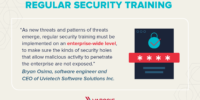In an era where cyber threats are constantly evolving, ensuring the security of your code is paramount. Whether you’re a seasoned developer or just starting, adopting practices to hack-proof your code is essential. In this guide, we’ll explore quick tips for cybersecurity vigilance, helping you fortify your code against potential threats. ️
1. Stay Informed about the Latest Threats
Cyber threats are dynamic, and new vulnerabilities emerge regularly. Stay informed about the latest security threats and vulnerabilities relevant to your coding environment. Subscribing to security newsletters, following cybersecurity blogs, and participating in relevant forums are excellent ways to stay updated.
2. Use Strong Authentication Mechanisms
Ensure that your applications and systems use strong authentication mechanisms. Implement multi-factor authentication (MFA) whenever possible. Strong authentication adds an extra layer of security, making it significantly harder for unauthorized users to gain access.
3. Regularly Update Dependencies and Libraries
Keep your dependencies and libraries up to date. Developers often use third-party libraries, and vulnerabilities in these can pose risks. Regularly check for updates and patches, and apply them promptly. This simple practice can mitigate the risk of exploiting known vulnerabilities.
4. Secure Sensitive Data with Encryption
When dealing with sensitive data, always use encryption. Whether it’s data at rest or in transit, encryption ensures that even if unauthorized access occurs, the data remains unreadable. Implementing robust encryption practices is a fundamental step in protecting sensitive information.
5. Validate User Input Thoroughly
Unvalidated user input is a common entry point for many cyber attacks, such as SQL injection and cross-site scripting. Thoroughly validate and sanitize user input to prevent malicious code injection. Implement input validation checks on both the client and server sides of your application. ✅
6. Practice Least Privilege Principle
Follow the principle of least privilege, ensuring that users and processes have the minimum access required to perform their tasks. Avoid giving unnecessary permissions, as this reduces the potential impact of a security breach. Restrict access to critical resources based on job responsibilities.
7. Conduct Regular Security Audits and Code Reviews
Regularly conduct security audits and code reviews to identify potential vulnerabilities. Automated tools can assist in finding common issues, but manual reviews by experienced developers and security experts are invaluable. A thorough review process enhances code quality and security. ️
8. Implement Intrusion Detection and Monitoring
Implement intrusion detection systems and monitoring tools to detect unusual activities. These systems can help identify potential security incidents in real-time, allowing for swift responses. Regularly review logs and set up alerts for suspicious activities.
9. Educate Your Development Team
Invest in the cybersecurity education of your development team. Awareness of security best practices and common attack vectors is crucial. Regular training sessions and workshops can empower your team to make security-conscious decisions during the development process.
10. Have an Incident Response Plan in Place
Prepare for the worst-case scenario by having an incident response plan in place. Define the steps to be taken in the event of a security breach. A well-prepared response can minimize the impact of a security incident and facilitate a faster recovery.
Conclusion
Securing your code is an ongoing process that requires vigilance and proactive measures. Stay informed about the latest threats, use strong authentication, keep dependencies updated, encrypt sensitive data, validate user input, practice the least privilege principle, conduct regular audits and code reviews, implement intrusion detection, educate your team, and have an incident response plan. By adopting these quick tips, you can enhance the cybersecurity posture of your code and contribute to a more secure digital landscape.








